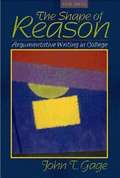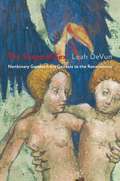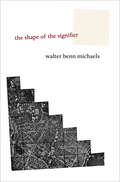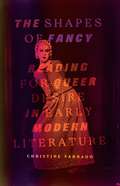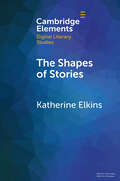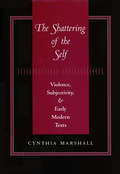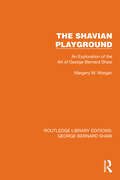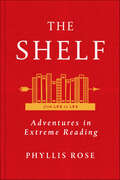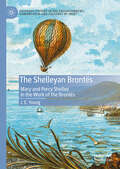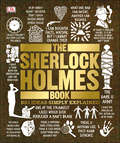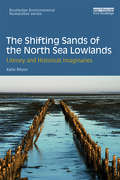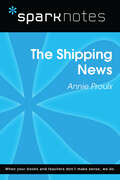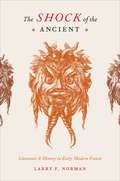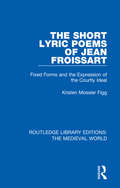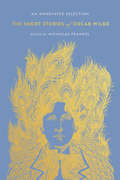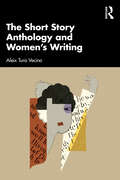- Table View
- List View
The Shape of Reason: Argumentative Writing in College
by John T. GageArgumentative reasoning addresses ideas that the writer takes seriously enough to want to explore and support with good reasons.
The Shape of Sex: Nonbinary Gender from Genesis to the Renaissance
by Leah DeVunThe Shape of Sex is a pathbreaking history of nonbinary sex, focusing on ideas and individuals who allegedly combined or crossed sex or gender categories from 200–1400 C.E. Ranging widely across premodern European thought and culture, Leah DeVun reveals how and why efforts to define “the human” so often hinged on ideas about nonbinary sex.The Shape of Sex examines a host of thinkers—theologians, cartographers, natural philosophers, lawyers, poets, surgeons, and alchemists—who used ideas about nonbinary sex as conceptual tools to order their political, cultural, and natural worlds. DeVun reconstructs the cultural landscape navigated by individuals whose sex or gender did not fit the binary alongside debates about animality, sexuality, race, religion, and human nature. The Shape of Sex charts an embrace of nonbinary sex in early Christianity, its brutal erasure at the turn of the thirteenth century, and a new enthusiasm for nonbinary transformations at the dawn of the Renaissance. Along the way, DeVun explores beliefs that Adam and Jesus were nonbinary-sexed; images of “monstrous races” in encyclopedias, maps, and illuminated manuscripts; justifications for violence against purportedly nonbinary outsiders such as Jews and Muslims; and the surgical “correction” of bodies that seemed to flout binary divisions.In a moment when questions about sex, gender, and identity have become incredibly urgent, The Shape of Sex casts new light on a complex and often contradictory past. It shows how premodern thinkers created a system of sex and embodiment that both anticipates and challenges modern beliefs about what it means to be male, female—and human.
The Shape of the Signifier: 1967 to the End of History
by Walter Benn MichaelsThe Shape of the Signifier is a critique of recent theory--primarily literary but also cultural and political. Bringing together previously unconnected strands of Michaels's thought--from "Against Theory" to Our America--it anatomizes what's fundamentally at stake when we think of literature in terms of the experience of the reader rather than the intention of the author, and when we substitute the question of who people are for the question of what they believe. With signature virtuosity, Michaels shows how the replacement of ideological difference (we believe different things) with identitarian difference (we speak different languages, we have different bodies and different histories) organizes the thinking of writers from Richard Rorty to Octavia Butler to Samuel Huntington to Kathy Acker. He then examines how this shift produces the narrative logic of texts ranging from Toni Morrison's Beloved to Michael Hardt and Toni Negri's Empire. As with everything Michaels writes, The Shape of the Signifier is sure to leave controversy and debate in its wake.
The Shapes of Fancy: Reading for Queer Desire in Early Modern Literature
by Christine VarnadoExploring forms of desire unaccounted for in previous histories of sexuality What can the Renaissance tell us at our present moment about who and what is &“queer,&” as well as the political consequences of asking? In posing this question, The Shapes of Fancy offers a powerful new method of accounting for ineffable and diffuse forms of desire, mining early modern drama and prose literature to describe new patterns of affective resonance.Starting with the question of how and why readers seek traces of desire in texts from bygone times and places, The Shapes of Fancy demonstrates a practice of critical attunement to the psychic and historical circulations of affect across time within texts, from texts to readers, and among readers. Closely reading for uncharted desires as they recur in early modern drama, witchcraft pamphlets, and early Atlantic voyage narratives and demonstrating how each is structured by qualities of secrecy, impossibility, and excess, Christine Varnado follows four &“shapes of fancy&”: the desire to be used to others&’ ends; indiscriminate, bottomless appetite; paranoid self-fulfilling suspicion; and melancholic longings for impossible transformations and affinities. These affective dynamics go awry in atypical and perverse ways. In other words, argues Varnado, these modes of feeling are recognizable on the page or stage as &“queer&” because of how, and not by whom, they are expressed.This new theorization of desire expands the notion of queerness in literature, decoupling the literary trace of queerness from the binary logics of same-sex versus opposite-sex and normative versus deviant that have governed early modern sexuality studies. Providing a set of methods for analyzing affect and desire in texts from any period, The Shapes of Fancy stages an impassioned defense of the inherently desirous nature of reading, making a case for readerly investment and identification as vital engines of meaning making and political insight.
The Shapes of Stories: Sentiment Analysis for Narrative (Elements in Digital Literary Studies)
by Katherine ElkinsSentiment analysis has gained widespread adoption in many fields, but not—until now—in literary studies. Scholars have lacked a robust methodology that adapts the tool to the skills and questions central to literary scholars. Also lacking has been quantitative data to help the scholar choose between the many models. Which model is best for which narrative, and why? By comparing over three dozen models, including the latest Deep Learning AI, the author details how to choose the correct model—or set of models—depending on the unique affective fingerprint of a narrative. The author also demonstrates how to combine a clustered close reading of textual cruxes in order to interpret a narrative. By analyzing a diverse and cross-cultural range of texts in a series of case studies, the Element highlights new insights into the many shapes of stories.
The Shaping of News: A Framework for Analysis
by Julie FirmstoneThis book provides readers with the understanding required to analyse the range of key factors that shape the production of news, and to assess their implications for the role of news and journalism in democracy. It brings existing research together under the umbrella of a central organising framework to explore how news and its production is shaped by a multiplicity of factors including the norms, values, role perceptions and ethics associated with journalism as a profession, the role of news sources, the changing character and significance of news audiences, the aims and objectives of news organisations, and the political, economic and social contexts within which news is produced. Exploring these factors in depth, using examples, and considering the changing conditions of news production, the chapters chart significant changes, challenges, and responses to provide the essential background for understanding the consequences of current transformations for the democratic qualities of news.
The Shaping of the Nazi State (Routledge Library Editions: Nazi Germany and the Holocaust)
by Peter D. StachuraRepresenting the scholarship of historians who have largely based their findings on previously unpublished material, this volume (originally published in 1978) provides a critical and provocative assessment of many established opinions on significant themes related to the dramatic rise and development of Adolf Hitler’s Nazi Movement. The volume discusses among other things: The development of Hitler’s foreign policy ideas The contributions of Gottfried Feder and Gregor Strasser to the successful growth of the Nazi party The social composition of the Stormtroopers The bureaucratic structure of the Third Reich The character and scope of resistance within Germany to the regime
The Shattering of the Self: Violence, Subjectivity, and Early Modern Texts
by Cynthia MarshallIn The Shattering of the Self: Violence, Subjectivity, and Early Modern Texts, Cynthia Marshall reconceptualizes the place and function of violence in Renaissance literature. During the Renaissance an emerging concept of the autonomous self within art, politics, religion, commerce, and other areas existed in tandem with an established, popular sense of the self as fluid, unstable, and volatile. Marshall examines an early modern fascination with erotically charged violence to show how texts of various kinds allowed temporary release from an individualism that was constraining. Scenes such as Gloucester's blinding and Cordelia's death in King Lear or the dismemberment and sexual violence depicted in Titus Andronicus allowed audience members not only a release but a "shattering"—as opposed to an affirmation—of the self.Marshall draws upon close readings of Shakespearean plays, Petrarchan sonnets, John Foxe's Acts and Monuments of the Christian Martyrs, and John Ford's The Broken Heart to successfully address questions of subjectivity, psychoanalytic theory, and identity via a cultural response to art. Timely in its offering of an account that is both historically and psychoanalytically informed, The Shattering of the Self argues for a renewed attention to the place of fantasy in this literature and will be of interest to scholars working in Renaissance and early modern studies, literary theory, gender studies, and film theory.
The Shavian Playground: An Exploration of the Art of George Bernard Shaw (Routledge Library Editions: George Bernard Shaw)
by Margery M. MorganIn The Shavian Playground, originally published in 1972, Shaw’s plays are examined as self-contained imaginative structures intended for theatrical performance. Beginning with a consideration of his novels, the book covers the whole span of Shaw’s career as a dramatist playing special attention to critically and theatrically neglected plays, and offering fresh interpretations of others.
The She-Wolf and Other Stories
by Giovanni VergaThis title is part of UC Press's Voices Revived program, which commemorates University of California Press’s mission to seek out and cultivate the brightest minds and give them voice, reach, and impact. Drawing on a backlist dating to 1893, Voices Revived makes high-quality, peer-reviewed scholarship accessible once again using print-on-demand technology. This title was originally published in 1973.
The Shelf: From LEQ to LES: Adventures in Extreme Reading
by Phyllis Rose“Exhilarating, adventurous, original . . . The Shelf is a reminder of what reading and writing are all about.” —Azar Nafisi,#1 New York Times–bestselling author of Reading Lolita in TehranAfter a career of reading from syllabuses and writing about canonical books, Phyllis Rose decided to read like an explorer. Casting herself into the untracked wilderness of the New York Society Library's stacks, she chose a shelf of fiction almost at random and read her way through it.What results is a spirited experiment in “Off-Road or Extreme Reading.” Rose's shelf of roughly thirty books has everything she could wish for—a remarkable variety of authors and a range of literary ambitions and styles. The early-nineteenth-century Russian classic A Hero of Our Time by Mikhail Lermontov is spine by spine with The Phantom of the Opera by Gaston Leroux. Stories of French Canadian farmers sit beside tales about aristocratic Austrians. California detective novels and a novel from an Afrikaans writer who fascinates Rose to the extent that she ends up watching a YouTube video of his funeral.A joyous testament to the thrill of engagement with books high and low, The Shelf leaves us with the feeling that there are treasures to be found on every library or bookstore shelf.“Simple but radical.” —Chicago Tribune“Rose is consistently generous, knowledgeable, and chatty, with a knack for connecting specific incidents to large social trends.” —The New Yorker“Immensely appealing . . . . teaches us much about how to approach life as it does about how to read books.” — Boston Globe“Readers of The Shelf will feel befriended.” —The New York Times“Rose rallies readers to affirm our love of literature and libraries.” —Booklist (starred review)
The Shelleyan Brontës: Mary and Percy Shelley in the Work of the Brontës (Palgrave Studies in the Enlightenment, Romanticism and Cultures of Print)
by J. E. YoungThis book explores the significant textual relationship between Mary and Percy Shelley and the early works of the Brontë siblings. Through a detailed examination of the Shelleyan narrative accessible to the Brontës from their childhood to their final novels, this study argues for a fresh perspective on the Brontës' engagement with the Shelleys in both their juvenilia and later seven novels. In this respect, the book considers the Brontës as readers rather than exclusively as writers, viewing them as a product of the early nineteenth-century literary marketplace which maintained affinities to Romanticism. Reading, rewriting, and appropriating the textual Shelleys was a fundamental vein stemming the Brontës’ writing from childhood, with Mary epitomising the model for what the sisters would eventually become: the female novelist.
The Sherlock Holmes Book: Big Ideas Simply Explained (DK Big Ideas)
by DKDiscover the key ideas, themes, and plotlines behind every case investigated by Sherlock Holmes and Dr. Watson in the famous and celebrated stories of Sir Arthur Conan Doyle with this original, graphics-led book.Using the "Big Ideas" series' trademark combination of witty illustrations, clear graphics, and inspirational quotes, The Sherlock Holmes Book is the perfect primer for newcomers and devoted readers alike. From the first Holmes novel, A Study in Scarlet, to the masterpiece that is The Hound of the Baskervilles, to the final Holmes tale The Adventure of Shoscombe Old Place, The Sherlock Holmes Book explores every facet of Sir Arthur Conan Doyle's master detective, his world, and his ongoing appeal.Packed with detailed plot summaries, a full analysis of the major characters and themes, and essays on the world of Sherlock Holmes, the book is essential reading for fans of the world's most famous detective.Series Overview: Big Ideas Simply Explained series uses creative design and innovative graphics along with straightforward and engaging writing to make complex subjects easier to understand. With over 7 million copies worldwide sold to date, these award-winning books provide just the information needed for students, families, or anyone interested in concise, thought-provoking refreshers on a single subject.
The Shetland Dialect (Routledge Studies in World Englishes)
by Peter SundkvistThe traditional dialect spoken in the Shetland Isles, the northernmost part of Scotland and Britain, is highly distinct. It displays distinct, characteristic features on all linguistic levels and particularly in its sound system, or its phonology. The dialect is one of the lesser- known varieties of English within the Inner Circle. Increasing interest in the lesser- known varieties of English in recent years has brought a realization that there are still blanks on the map, even within the very core of the Inner Circle. Sundkvist’s comprehensive treatise draws upon results from a three- year research project funded by the Bank of Sweden Tercentenary Foundation, for which a phonological survey of the Shetland dialect was carried out between 2010 and 2012. This book is a useful resource for those working on historical linguistics and is intended to serve as a comprehensive description and accessible reference source on one of the most distinct lesser- known varieties of English within Britain. It documents and offers a systematic account of the rich regional variation as well as being a reference source for those studying the historical formation and emergence of the Shetland dialect and language variation and change in Shetland, as well as those within the broader field of Germanic linguistics.
The Shetland Dialect (Routledge Studies in World Englishes)
by Peter SundkvistThe traditional dialect spoken in the Shetland Isles, the northernmost part of Scotland and Britain, is highly distinct. It displays distinct, characteristic features on all linguistic levels and particularly in its sound system, or its phonology. The dialect is one of the lesser- known varieties of English within the Inner Circle. Increasing interest in the lesser- known varieties of English in recent years has brought a realization that there are still blanks on the map, even within the very core of the Inner Circle. Sundkvist’s comprehensive treatise draws upon results from a three- year research project funded by the Bank of Sweden Tercentenary Foundation, for which a phonological survey of the Shetland dialect was carried out between 2010 and 2012. This book is a useful resource for those working on historical linguistics and is intended to serve as a comprehensive description and accessible reference source on one of the most distinct lesser- known varieties of English within Britain. It documents and offers a systematic account of the rich regional variation as well as being a reference source for those studying the historical formation and emergence of the Shetland dialect and language variation and change in Shetland, as well as those within the broader field of Germanic linguistics.
The Shifting Sands of the North Sea Lowlands: Literary and Historical Imaginaries (Routledge Environmental Humanities)
by Katie RitsonGlobal seawater levels are rising and the low-lying coasts of the North Sea basin are amongst the most vulnerable in Europe. In our current moment of environmental crisis, the North Sea coasts are literary arenas in which the challenges and concerns of the Anthropocene are being played out. This book shows how the fragile landscapes around the North Sea have served as bellwethers for environmental concern both now and in the recent past. It looks at literary sources drawn from the countries around the North Sea (Denmark, Germany, the Netherlands, and England) from the mid-nineteenth century onwards, taking them out of their established national and cultural contexts and reframing them in the light of human concern with fast-changing and hazardous environments. The six chapters serve as literary case studies that highlight memories of flood disaster and recovery, attempts to engineer the landscape into submission, perceptions of the landscape as both local and global, and the imagination of the future of our planet. This approach, which combines environmental history and ecocriticism, shows the importance of cultural artefacts in understandings of, and responses to, environmental change, and advocates for the importance of literary studies in the environmental humanities. This book will be of great interest to students and scholars of the Environmental Humanities, including Eco-criticism and Environmental History, as well as anyone studying literature from the Germanic philologies.
The Shipment and Lear
by Young Jean Lee"A subversive, seriously funny new theater piece by the adventurous playwright Young Jean Lee. . . . Ms. Lee does not shy away from prodding the audience's racial sensitivities--or insensitivities--in a style that is sometimes sly and subtle, sometimes as blunt as a poke in the eye."--Charles Isherwood, The New York Times"Lee is a facetious provocateur; she does whatever she can to get under our skins--with laughs and with raw, brutal talk . . . [and with] so ingenious a twist, such a radical bit of theatrical smoke and mirrors, that we are forced to confront our own preconceived notions of race."--Hilton Als, The New YorkerWith The Shipment, her latest work taking on identity politics, Young Jean Lee "confirms herself as one of the best experimental playwrights in America" (Time Out New York). The Korean American theater artist has taken on cultural images of black America, in a play that begins with sketches of African American clichés--an angry, foul-mouthed comedian; an aspiring young rapper who ends up in prison--and ends with a seemingly naturalistic parlor comedy, which slyly reveals the larger game Lee is playing, leaving us to consider the many ways that we see the world through a racial lens.Young Jean Lee is a playwright, director, and artistic director of her own OBIE Award-winning theater company, which as been producing her plays since 2003. Her other works include Songs of Dragons Flying to Heaven, Church, The Appeal, and Pullman, WA, and they have been produced across the country and internationally.
The Shipping News (SparkNotes Literature Guide Series)
by SparkNotesThe Shipping News (SparkNotes Literature Guide) by Annie Proulx Making the reading experience fun! Created by Harvard students for students everywhere, SparkNotes is a new breed of study guide: smarter, better, faster. Geared to what today's students need to know, SparkNotes provides: *Chapter-by-chapter analysis *Explanations of key themes, motifs, and symbols *A review quiz and essay topicsLively and accessible, these guides are perfect for late-night studying and writing papers
The Shock of the Ancient: Literature & History in Early Modern France
by Larry F. NormanThe cultural battle known as the Quarrel of the Ancients and Moderns served as a sly cover for more deeply opposed views about the value of literature and the arts. One of the most public controversies of early modern Europe, the Quarrel has most often been depicted as pitting antiquarian conservatives against the insurgent critics of established authority. The Shock of the Ancient turns the canonical vision of those events on its head by demonstrating how the defenders of Greek literature—rather than clinging to an outmoded tradition—celebrated the radically different practices of the ancient world. At a time when the constraints of decorum and the politics of French absolutism quashed the expression of cultural differences, the ancient world presented a disturbing face of otherness. Larry F. Norman explores how the authoritative status of ancient Greek texts allowed them to justify literary depictions of the scandalous. The Shock of the Ancient surveys the diverse array of aesthetic models presented in these ancient works and considers how they both helped to undermine the rigid codes of neoclassicism and paved the way for the innovative philosophies of the Enlightenment. Broadly appealing to students of European literature, art history, and philosophy, this book is an important contribution to early modern literary and cultural debates.
The Short Lyric Poems of Jean Froissart: Fixed Forms and the Expression of the Courtly Ideal (Routledge Library Editions: The Medieval World #12)
by Kristen Mossler FiggOriginally published in 1994, The Short Lyric Poems of Jean Froissart is a meticulous reading of the important but generally neglected short lyric poems of Jean Froissart. The book situates Froissart within the cultural and literary context of fourteenth-century Europe and examines a representative number of his lyric forms (pastourelles, chansons royales, ballades, virelais, and rondeaux) demonstrating their richness of theme and poetic virtuosity. The book provides a readable and reliable English translation, making it possible for English scholars unfamiliar with the original Middle French forms to understand and appreciate the influence Froissart had on Chaucer and other authors of the age. The book focuses on themes, techniques, meters, and rhythms that Froissart employed in his poetry, on how his poetry fits poetic tradition, and on the place of Froissart in literary history.
The Short Prose Reader (12th edition)
by Gilbert H. Muller Harvey S. WienerThis rhetorically organized reader, maintains the best features of the earlier editions: lively reading selections supported by helpful apparatus to integrate reading and writing in college composition and reading courses. In working through the text, the student progresses from key aspects of the writing and reading processes to chapters on the essential patterns of writing and then to more rigorous forms of analysis and argument. Each chapter provides diverse and lively prose models suited for discussion, analysis, and imitation.
The Short Stories of Frank Yerby
by Veronica T. WatsonFrank Yerby’s first novel, The Foxes of Harrow, established him as a writer and launched a forty-nine-year career in which he published thirty-three novels. He also became the first African American writer to sell more than a million copies of his work and to have a book adapted into a movie by a Hollywood studio. He garnered legions of loyal fans of his writing. Yet, few know that Yerby began his writing career with the publication of a short story in his school newspaper in 1936, the first of nine stories he would publish in the 1930s and ’40s. Most stories appeared in small journals and magazines and were largely forgotten once he started writing novels.This groundbreaking collection gives readers access to an intriguingly diverse selection of Yerby’s short fiction. The stories collected here, eleven of which have never previously been published, paint a picture of Yerby as an intellectual who thought deeply about several philosophical questions at the center of understanding what it means to be human. The stories also reveal him as an artist committed to exploring a range of human drives, longings, conflicts, and passions, from the quirky to the serious, and in a variety of writing styles. With an attention to historical detail, voice, and character that he became known for, these stories give us new insights into this important African American writer who dared to believe he could earn a living as a writer.
The Short Stories of Oscar Wilde: An Annotated Selection
by Oscar WildeAn innovative new edition of nine classic short stories from one of the greatest writers of the Victorian era.“I cannot think other than in stories,” Oscar Wilde once confessed to his friend André Gide. In this new selection of his short fiction, Wilde’s gifts as a storyteller are on full display, accompanied by informative facing-page annotations from Wilde biographer and scholar Nicholas Frankel. A wide-ranging introduction brings readers into the world from which the author drew inspiration.Each story in the collection brims with Wilde’s trademark wit, style, and sharp social criticism. Many are reputed to have been written for children, although Wilde insisted this was not true and that his stories would appeal to all “those who have kept the childlike faculties of wonder and joy.” “Lord Arthur Savile’s Crime” stands alongside Wilde’s comic masterpiece The Importance of Being Earnest, while other stories—including “The Happy Prince,” the tale of a young ruler who had never known sorrow, and “The Nightingale and the Rose,” the story of a nightingale who sacrifices herself for true love—embrace the theme of tragic, forbidden love and are driven by an undercurrent of seriousness, even despair, at the repressive social and sexual values of Wilde’s day. Like his later writings, Wilde’s stories are a sweeping indictment of the society that would imprison him for his homosexuality in 1895, five years before his death at the age of forty-six.Published here in the form in which Victorian readers first encountered them, Wilde’s short stories contain much that appeals to modern readers of vastly different ages and temperaments. They are the perfect distillation of one of the Victorian era’s most remarkable writers.
The Short Story (The Critical Idiom Reissued #34)
by Ian ReidFirst published in 1977, this book examines the short story, which is one of the most widely read of all modern genres. The study begins by examining some preliminary problems of definition before going on to trace the emergence of what is usually meant by ‘the modern short story’ and examine the various kinds of narrative from which it derives, such as the sketch, the yarn, Märchen, parable and fable. The final chapter considers the possibility that there are certain structural properties belonging distinctively to the short story. This book will be of interest to those studying literature and creative writing.
The Short Story Anthology and Women's Writing
by Aleix Tura VecinoHundreds of anthologies of women’s short stories have appeared in the literary market between the 1970s and now. This publishing and cultural phenomenon is considered for the first time in this book, which argues that, during this period, anthologies have become a literary technology used not only to make visible female short story writers, but also to think about, and mould ideas of, womanhood. Through creative and contextualised readings of the most important anthologies produced in this period, this study shows that this literary form has contributed to, and in some cases pioneered, key developments in gender theory and feminist thought, including questions of political combination among women which underlie contemporary global movements such as #MeToo. In doing so, the book also develops the first book-length conceptualisation of the features and meaning-making mechanisms of the short story anthology as a literary form.This book will benefit academics and students working in the fields of short fiction, publishing, and women’s studies, as well as feminist scholars and a growing number of specialists interested in the anthology as a literary form worldwide.
